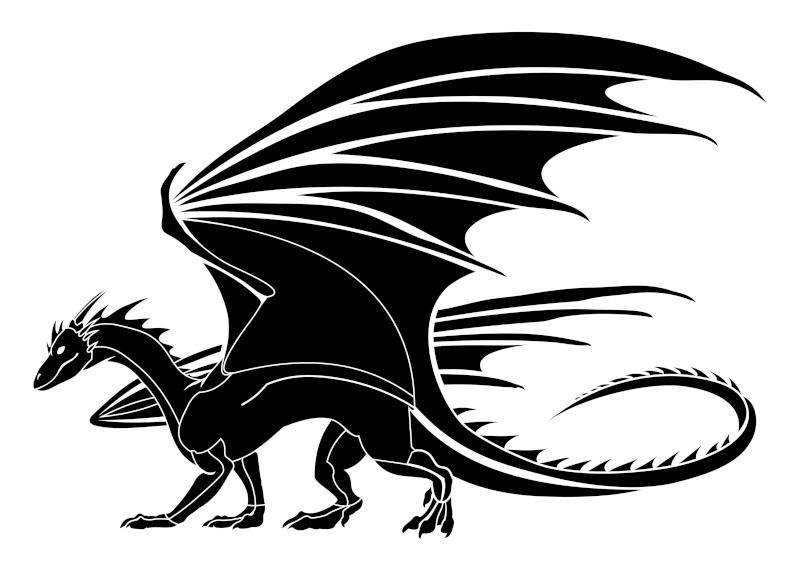Discover historic dragon drawings and paintings from the history of art, and learn tips and techniques for drawings your own dragons.
Introduction to Dragon Drawings
Dragons are popular mythical creatures which have appeared in countless different cultures and civilizations. In each one they could carry different symbolic meaning, whilst other artists simply appreciated their aesthetic qualities and appreciated the scope for freedom of expression that comes from working with mythical creatures. They have particularly unusual features and can be particularly scary, though more recent interpretations have sometimes pictured them in a friendlier manner.
With no clear definition on how a dragon should look, different cultures across the ages have drawn them in different ways, and the list of images below will indicate this interesting variety of interpretations. Today we tend to see dragons used in children's books and cartoons, when previously they were used in full scale pen and ink paintings in Japanese art, or even represented in costume for various cultural events.
List of Dragon Drawings and Paintings
Below we have provided a list of public domain dragon drawings and paintings, courtesy of Rawpixel. You can use these for inspiration for your own work, as we have included many different styles regarding composition and form, as well as color. There are opportunities to trace your own drawings, and then learn how to draw your own dragon, potentially adding extra detail of your own afterwards.
Each image is accompanied by a brief description, as well as information on the artist themselves, where that exists. Below this list of dragon images, you can also find discussion around a number of themes and topics related to dragon art, such as the history of this sub-genre, and tips and techniques to help you create some art of your own, and the types of mediums and tools that you might use, whether you are a beginner or someone more experienced.
Black Dragon from Side Profile
This large dragon is drawn from a side profile and is filled entirely in a single tone of black. This would be a great option for tracing, particularly for beginners who want to learn the different parts of a dragon, and how to draw them. We see the large wings dominating this piece, with a long tail wrapping around at the back. The dragon looks elegant in this relatively modern-style, with clear lines which are typical of commercial illustration of recent times. A digital version of this could be swapped into alternative colors, such as red or green, which are common choices for dragons in art.
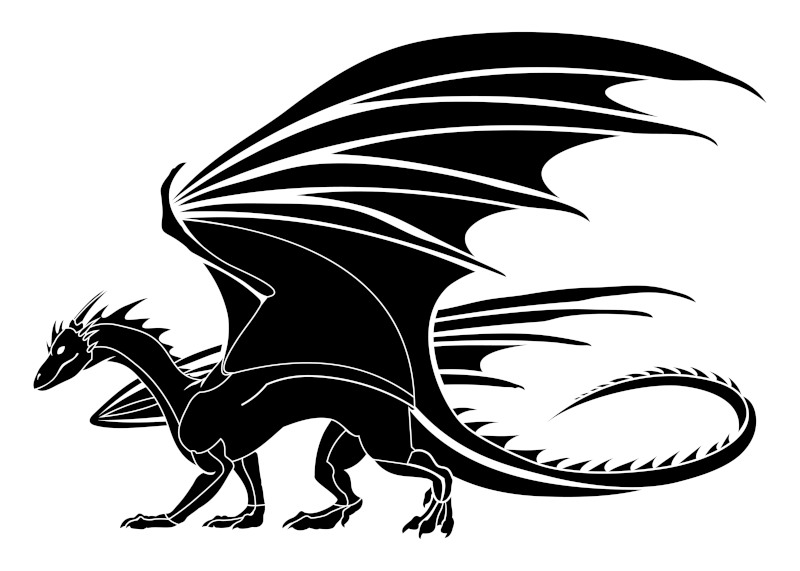 Black Dragon from Side Profile (image from public domain, courtesy of Rawpixel)
Black Dragon from Side Profile (image from public domain, courtesy of Rawpixel)
Flying Green Dragon
This scary illustration of a green dragon features its claws menacingly on display. It appears to be hovering in mid-flight, perhaps about to unleash its fire on an unseen opponent. The artist uses a small palette for this piece, but tones of white, cream and red help to add interest around the dragon's tongue, claws and stomach, contrasting against the dominant green which fills most of its form. There are also two tones of green to differentiate between the softer and harder elements of the dragon's wings. The jagged features to the back of the dragon's head continue its menacing appearance, as underlined by its aggressive posture and facial expression.
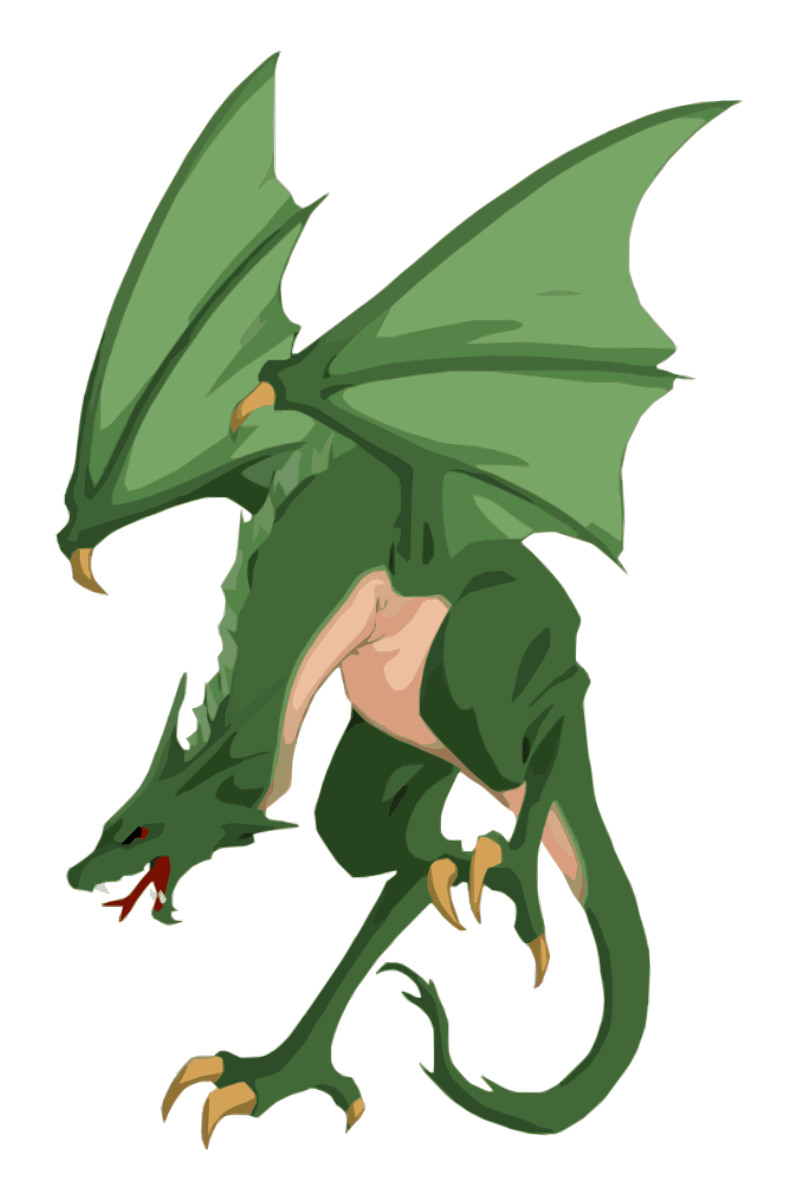 Flying Green Dragon (image from public domain, courtesy of Rawpixel)
Flying Green Dragon (image from public domain, courtesy of Rawpixel)
Fun Cartoon Red Dragon
This illustration captures a red dragon in a more friendly atmosphere and is more typical of modern dragon cartoons and films. In order to make these mythical creatures suitable for children, many animals and creatures such as this are re-imagined with human-like features. Their more intimidating characteristics are softened, with other examples being lions, cats and dogs. The artist puts this artwork together with transitions of color, from light to dark. There is also considerable detail added to the face, with prominent nostrils, ears and eyes, as well as horns. The claws you will notice are presented as small and unthreatening, greatily contrasting with the other styles shown in this article.
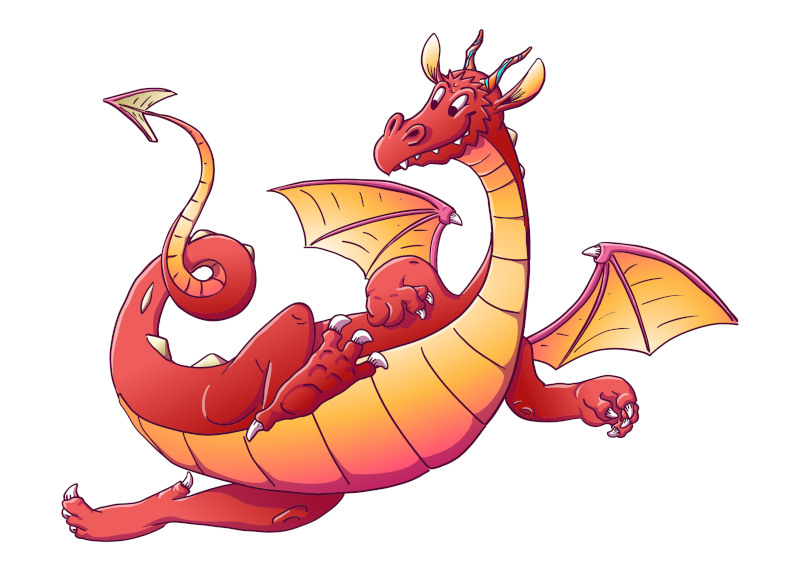 Fun Cartoon Red Dragon (image from public domain, courtesy of Rawpixel)
Fun Cartoon Red Dragon (image from public domain, courtesy of Rawpixel)
Dragon by Hokusai on the ceiling of a festival float, Hokusaikan, Obuse, Nagano, Japan
This stunning Japanese painting by Hokusai features a dragon looking directly at us, whilst looping around a red circle in the centre of the artwork. Many of the elements from this vintage artwork contain the same dragon characteristics that we would expect to see in more recent iterations, though there is also a stunning display of waves around the border of the work which relates to the famous Great Wave painting. Hokusai remains one of the most loved Japanese artists from this era of Woodblock printing, and their work would inspire many European artists who followed on in the 19th century. The level of detail within this painting is extraordinary, and it is a mystery why this artwork is not one of his most famous pieces.
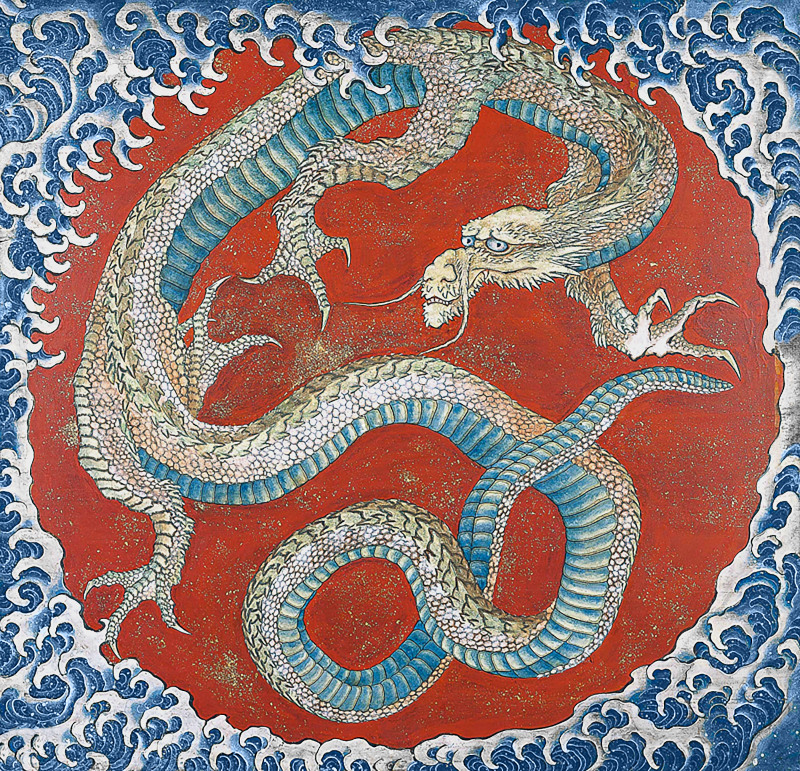 Dragon by Hokusai on the ceiling of a festival float, Hokusaikan, Obuse, Nagano, Japan (image from public domain, courtesy of Rawpixel)
Dragon by Hokusai on the ceiling of a festival float, Hokusaikan, Obuse, Nagano, Japan (image from public domain, courtesy of Rawpixel)
Silk Embroidered with Nine 5-Clawed Dragons in Gold
This exquisite design was completed on yellow silk, and is likely to derive from Asian art, perhaps Japanese or Chinese. Most cultures celebrated dragon-like creatures within their art, and also based certain festivals around this mythical creature. In the artwork below we find an interesting and creative composition method, in which the head is handled very differently to the rest of its body. The detail on the scales is extraordinary, showing considerable talent to convert this design into a pattern for cloth. The contrast of color is beautiful, and the artist then completes this display with a series of landscape-inspired features as a pattern across the rest of the scene, providing a busy and uplifting display.
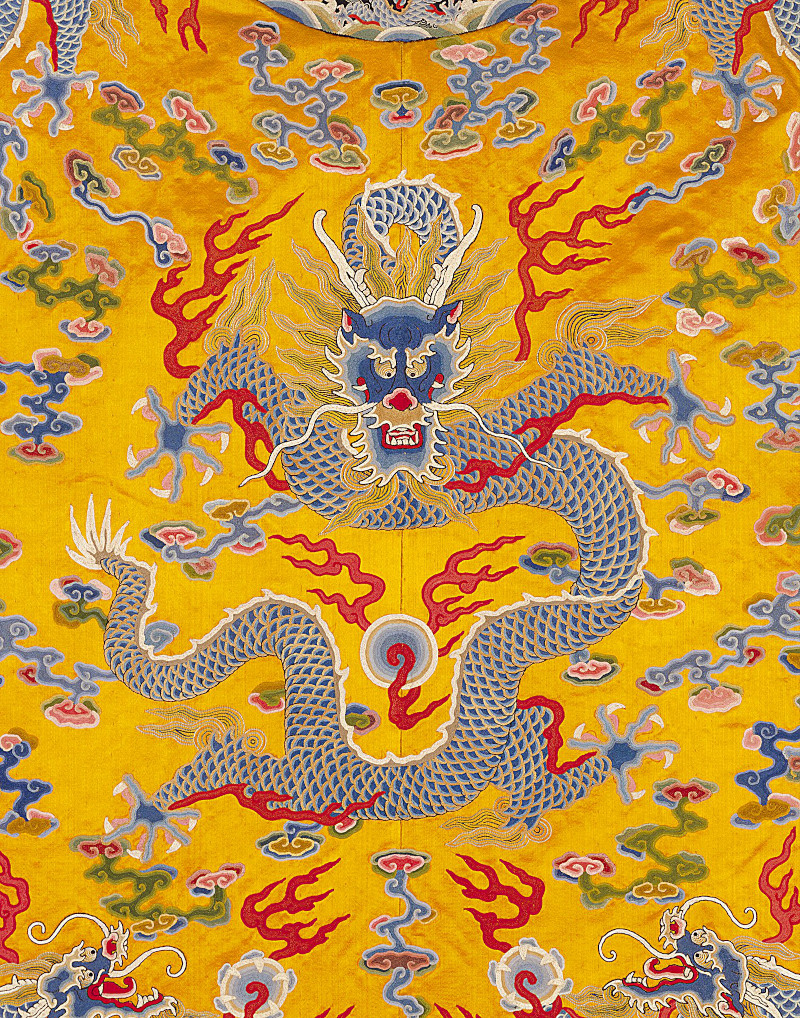 Silk Embroidered with Nine 5-Clawed Dragons in Gold (image from public domain, courtesy of Rawpixel)
Silk Embroidered with Nine 5-Clawed Dragons in Gold (image from public domain, courtesy of Rawpixel)
Green Dragon in Flight
This image of a green dragon in flight appear to be highly polished, with no visible signs of work by the artist. It might, therefore, have been produced using AI or CGI, where an incredible realism goes beyond the possibilities of human work. The touch of light reflecting from the dragon's shoulders and lower wings is an example of this, and with dragons being popular in fantasy art, there might be a link to computer design. This scary interpretation even includes sharp spikes from the wings themselves, whilst the teeth are on display to scare us. The dragon here is relatively slim and possibly more agile than other interpretations found within this article.
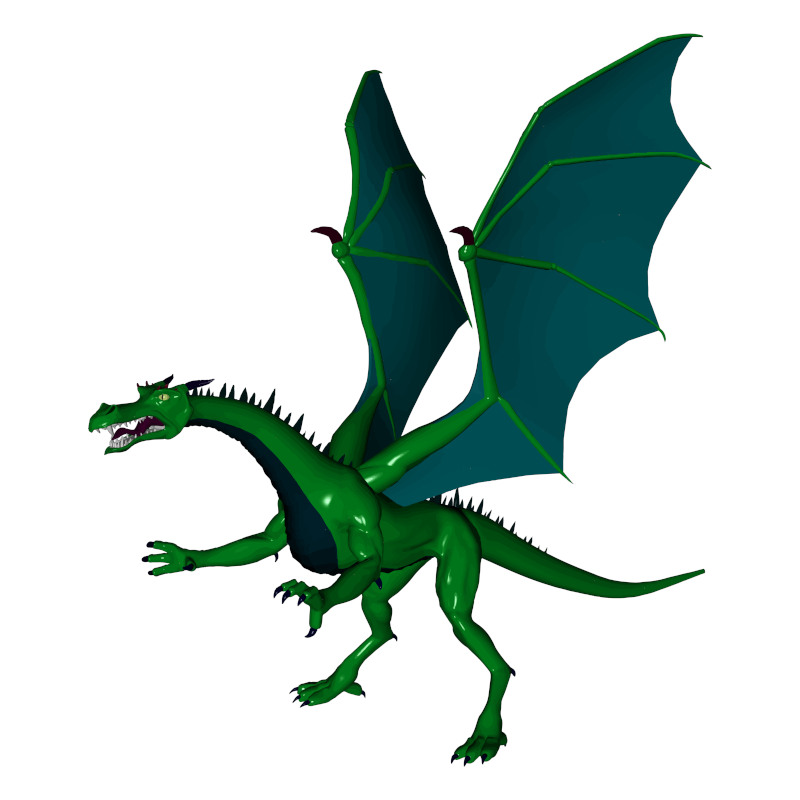 Green Dragon in Flight (image from public domain, courtesy of Rawpixel)
Green Dragon in Flight (image from public domain, courtesy of Rawpixel)
Outline of Black Dragon
This simple outline of a dragon in side profile could be a good starting point for those looking to trace a dragon as a beginner. You could easily fill in more detail later in order to practice your creative mind, but the initial outline will help to give you a clear starting point. Despite the single tone simplicity of this piece, there is still interesting detail added here, such as with the claws running from its feet, as well as the sharp spikes across its long, looping tail. It is these sharp dangers which add to the fearsome reputation of the dragon, even before it starts to throw fire at its enemy.
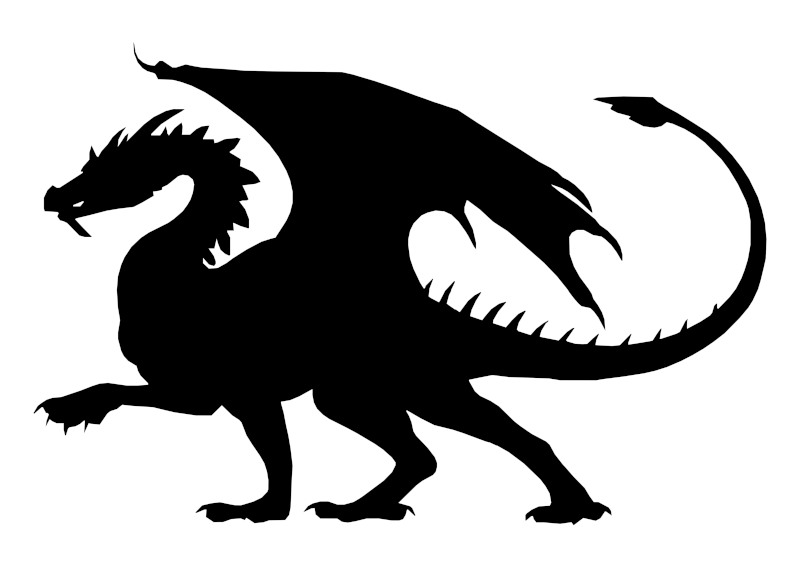 Outline of Black Dragon (image from public domain, courtesy of Rawpixel)
Outline of Black Dragon (image from public domain, courtesy of Rawpixel)
Large Dragon Drawing with Wings Open
In this highly detailed drawing we can see each and every detail of this frightening dragon. Its wings are enlarged in relation to the rest of its body, suggesting strong flight strengths. The tail only just extends to the back of the wings, which is a slighly unusual anatomical look to other iterations of dragons that we have seen across different cultures. The under detail of the stomach is detailed, with patchwork running across the length of the dragon and again we find considerable detail across its head, adding to the scary and intimidating nature of this mythical creature.
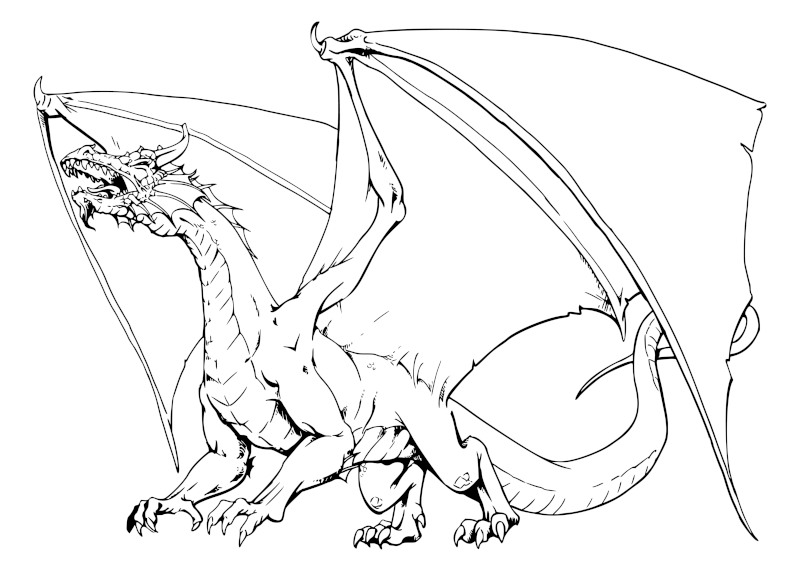 Large Dragon Drawing with Wings Open (image from public domain, courtesy of Rawpixel)
Large Dragon Drawing with Wings Open (image from public domain, courtesy of Rawpixel)
Japanese Art Dragon in front of Mount Fuji by Ogata Gekko
This breaktaking artwork by Ogata Gekko is likely to have come from the traditional woodblock print method from Japanese art. The dragon appears from behind a black cloud and heads towards the summit of a tall mountain, possibly Mount Fuji. In the distance this impressive natural structure has small amounts of snow, but is entirely tranquil and grand. The sky behind is left entirely flat in color, to avoid taking attention away from the two main focal points, namely the mountain and the dragon below. The artist signed the work in the bottom left corner, with titles for the piece written in traditional scripture in the top right of the piece, in two rectangles that are sectioned off from the rest of the design.
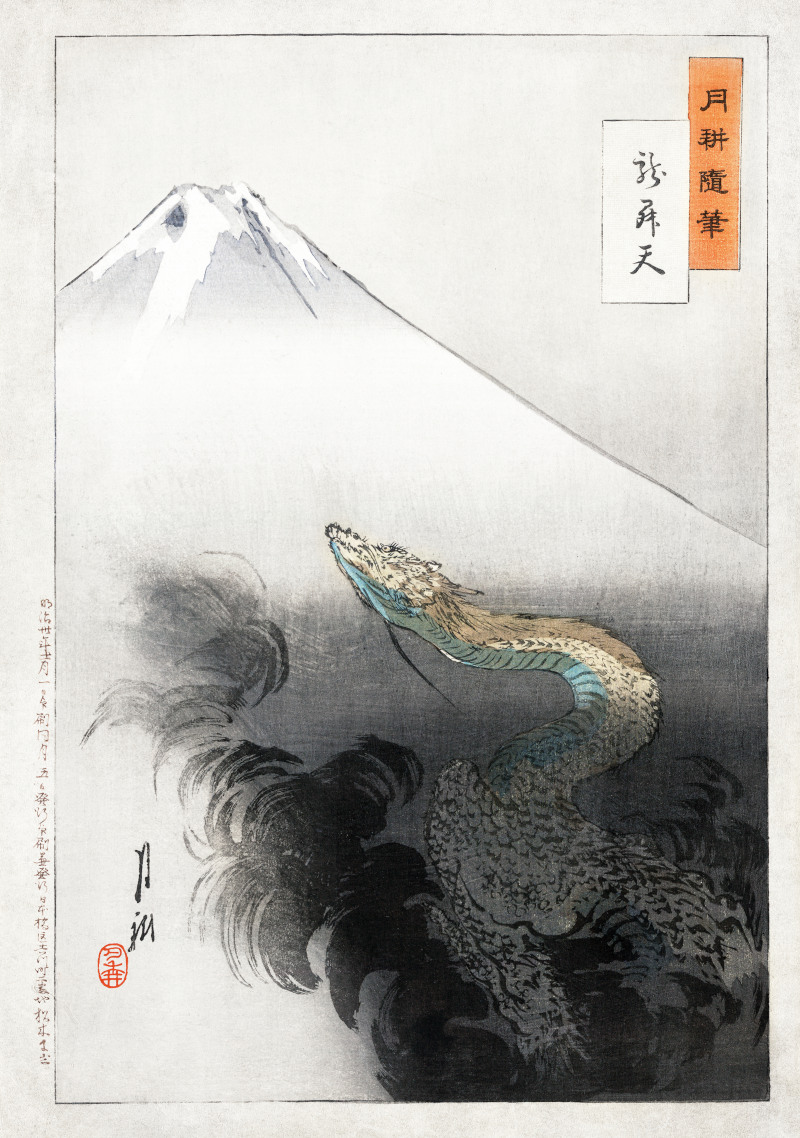 Japanese Art Dragon in front of Mount Fuji by Ogata Gekko (image from public domain, courtesy of Rawpixel)
Japanese Art Dragon in front of Mount Fuji by Ogata Gekko (image from public domain, courtesy of Rawpixel)
Chinese Asian Dragon Drawing
This highly detailed artwork comes from traditional Asian culture, probably either Chinese or Japanese art. There is considerable detail, with every scale hand drawn, and an elaborate design around the head of this mythical creature. Flourishes are inserted by the artist in every corner and this design mirrors the costumes used to represent dragons in a number of Asian festivals, some of which continue to this day. The sketch is completed entirely in black pen, and many artists from this region were highly skilled in this technique. This artwork could easily have been replicated alongside a patterned background, for a commercial artowrk.
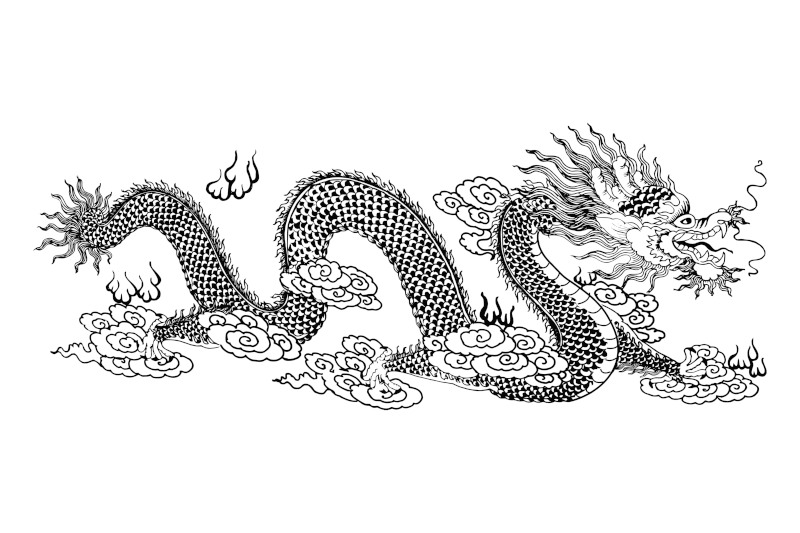 Chinese Asian Dragon Drawing (image from public domain, courtesy of Rawpixel)
Chinese Asian Dragon Drawing (image from public domain, courtesy of Rawpixel)
Vintage Mythical Dragon Black and White Artwork
This flat design could be used for a variety of purposes such as kitchen mats, book illustration, or fabric printing. The piece is carefully laid out into an approximate rectangle, and it could also be used in a similar manner to western coats of arms. The style is more artistic than accurate, with considerable flourishes that remind us of the traditional approach found in Japanese, Chinese and Indian art. This could also be etched, as negative space is used to produce some of the detail in this piece, such as the dotted elements across parts of the dragon's tail.
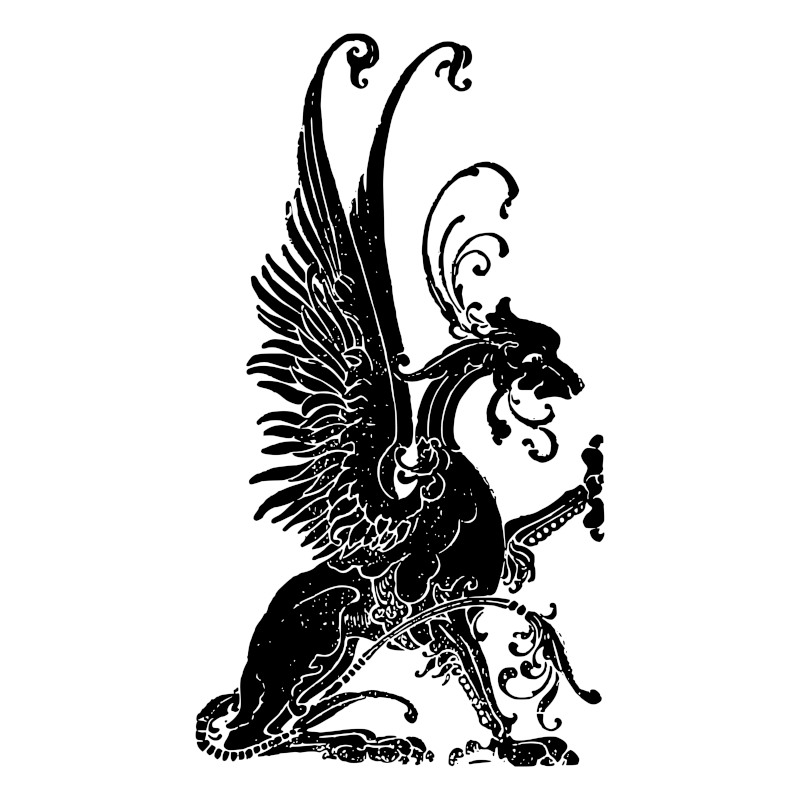 Vintage Mythical Dragon Black and White Artwork (image from public domain, courtesy of Rawpixel)
Vintage Mythical Dragon Black and White Artwork (image from public domain, courtesy of Rawpixel)
Elaborate Dragon Illustration
This highly elaborate design features an unusual use of curves in this flat drawing of a dragon. This style could be re-used in a variety of ways, being more of a commercial design for fabric patterns, or even digital illustration, rather than a sellable artwork. One could also imagine this being used as a product design for branding, or perhaps used as a supporting element in an illustrated book. This artistic interpretation has none of the scary fire-breathing nature of other works, and is more of a design device that can be re-used in many ways.
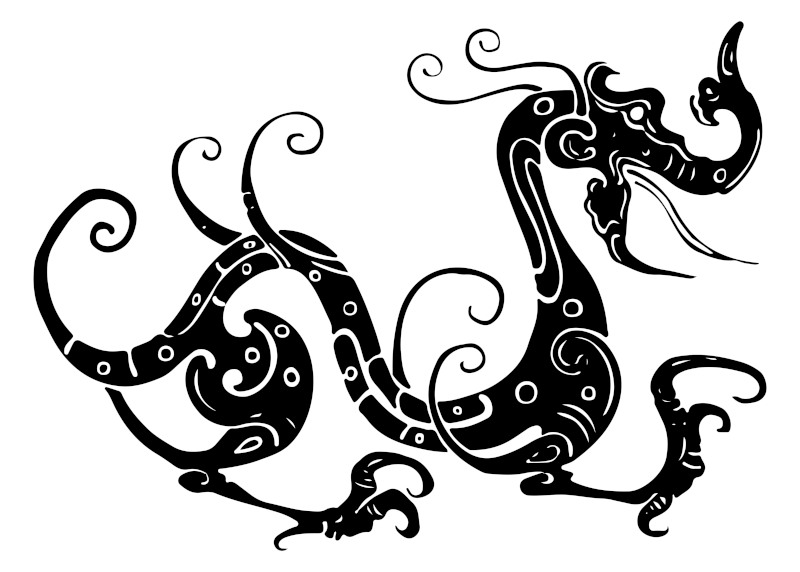 Elaborate Dragon Illustration (image from public domain, courtesy of Rawpixel)
Elaborate Dragon Illustration (image from public domain, courtesy of Rawpixel)
Introduction to Dragon Art
Dragon art is an interesting niche which has allowed artists to take creative advantage of a creature whose appearance is very much up for debate. As opposed to animals, who are known and understood, dragons can be created in a manner of ways, to suit different tastes. Typically, they are seen as scary, aggressive creatures to be feared, but equally they might appear within children's books as playful, lovable friends, in a similar manner to how dinosaurs are always sometimes re-invented in this manner.
Despite their size and danger, dragons can also be seen as majestic creatures, flying without obstruction across the skies. They can also inflict damage below without much resistance, making them a terrifying proposition. In order to understand some of the historical approaches taken to dragon art, it is necessary to delve into the meanings used by these cultures, and the different ways in which these images are spread across fashion design, homeware, commercial illustration and digital prints.
Historical Evolution of Dragon Depictions
Various creatures which bear a resemblance to dragons can be found in ancient civilizations in Mesopotamia, Egypt, and China. They would often feature a hybrid mix of elements, taken from different animals, as well as some from the artist's imagination. Over time these would start to merge into a more consistent look with which we are more familiar today. Hercules battled a multi-headed serpent-like creature known as the Hydra in Greek art, and this continued the use of dragon-like creatures in art, leading towards the more modern periods of European art which included the Renaissance.
They were also particularly popular in medieval times, often being used a as a way to demonstrate incredible levels of bravery by those willing to fight against them. China, Japan, and Korea incorporated them into various aspects of their culture, including woodblock prints, fabric patterns and also festivals. By more modern times, however, artists attempted to re-invent these creatures as friendlier, accessible figures who could appeal to children within illustrated books.
Creating Your Own Dragon Art
There are several stages to producing your own art, be it on dragons or any other topic. Firstly, you should do some research into dragons in art, be it drawings or paintings, even sculptures, and this should provide plenty of inspiration for your own ideas. As well as how you will draw the creature, also consider your style, be it traditional or modern, abstract or realistic. Then select your tools, starting with pencils for beginners, or oils or watercolors for those with more advanced artistic knowledge. You should then start to sketch simple ideas, without too much detail, before building up as you go.
Working in the main parts of the body with simple shapes is a great way to go, before moving onto smaller components. Color and texture can also be experimented with as you build confidence, and eventually you will need to ask for feedback on your work, in order to find areas in which to improve in later iterations. This can be done online or in person with friends and family.
The Use of Dragons in Chinese and Japanese Art
Dragons appeared frequently as motifs within Asian art, and were also sometimes incorporated into landscape scenes by masters such as Hokusai and Hiroshige. Their interpretations may have influenced Europeans, as their woodblock print designs were imported and later purchased by a number of artists. Asian festivals also incorporated dragons into their displays, with people running together under long costumes, or the creature being used instead as a patterned element as a type of graphical symbol. Artists would need to consider which use each dragon design would be used for, as this would impact the amount of detail needed, as well as whether it would be a flat, two-dimensional form or something with more depth.
Asian art is entirely unique and continues to draw support from a global audience. Whilst many prefer the 18th and 19th century prints, there is now considerable innovation in cartoons and other contemporary art.
Styles and Techniques in Dragon Art
When choosing the right approach for your work, there are many things to consider. Will you go for a realistic look, with considerable detail? Or perhaps create abstract forms in which the dragon is barely recognisable, but you can work with a truer freedom. Would you make use of surreal or fantastical ideas? These are common online and popular with younger audiences, where as more traditional approaches can draw on the work of eastern artists from previous centuries. You might even consider a dragon sculpture, which could be created from all manner of different materials, but normally this will require a little more space and beginners tend to prefer a simple pencil on paper instead.
Dragons in Film, Television and Book Illustration
Dragons continue to feature regularly in all manner of films, television programmes and also a number of books. The Hobbit is well known for its use of a dragon as a major character, whilst Crouching Tiger, Hidden Dragon remains one of the most famous Chinese films of all time. Games of Thrones, a popular TV production, also uses dragons as key elements of its storyline, and reflects the way in which they were viewed during medieval times, on which the story is roughly based around. Japanese Anime have also incorporated dragons into their contemporary work, which has also extended to comics and book illustrations in which are a similar use of line illustration and relatively little detail is used.
Conclusion: Dragons in the World of Art
To conclude, dragons are exciting creatures and make great subjects for art, with their unusual physical characteristics, menacing appearance and also their varying meaning across different cultures. Artists continue to find new ways of covering them within their work and currently the most common use of dragons is in the modern media of film and television, along with illustrative work for children's books. The future is likely to feature a greater use of digital art, with some artists drawing dragons on their tablet and mobile devices, as well as editing them through computer software.
Whilst many of the meanings of dragons in previous centuries has passed by today, dragons continue to be a source of inspiration for contemporary artists. The are also used in a number of badges and logos, representing strength, and it seems this magical creature will continue to appear in modern culture for years to come. We believe that this exhaustive collection of artworks has displayed the full variety of styles that has appeared over the preceding few centuries, and provided enough inspiration for you to draw some dragons of your own.



